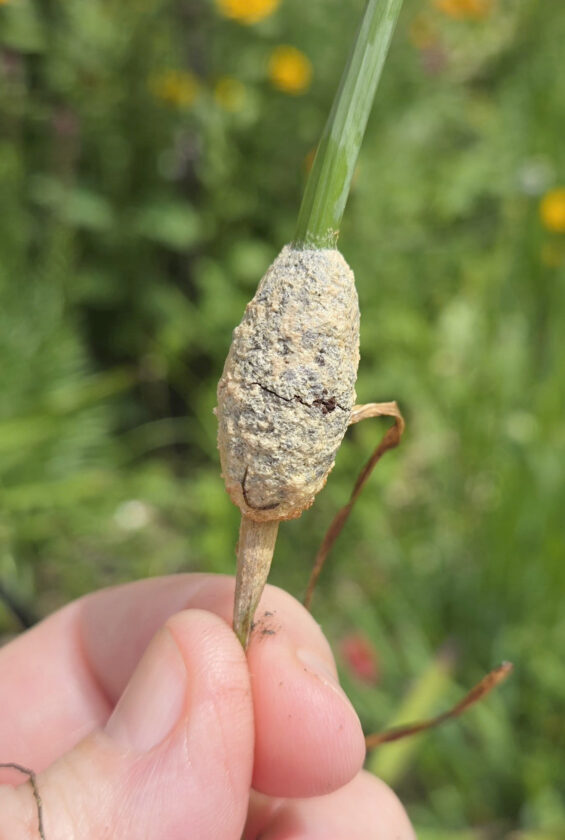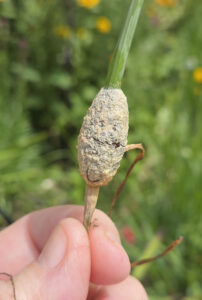Praying mantis — a northern unknown — found in Quinnesec
Northwoods notebook

The European mantis egg case that Phyllis Carlson of Quinnesec found in her garden July 15. Mantis species are virtually unknown this far north. (Phyllis Carlson photo)
As I said earlier, this seems to be a good “bug” year in terms of numbers. But even a good year can bring the unexpected.
A “frequent flyer” in this column, Phyllis Carlson of Quinnesec, on July 15 discovered a papery, cocoon-like mass attached to a grasslike plant in her garden.
It intrigued her enough to do a Google search with an unforeseen result: it was a European mantis egg case.
To have such an egg case means a mantis made it somehow to the Upper Peninsula and either had mated before the trip or found another of its kind here — which would be highly unlikely, given that mantids are almost unknown this far north and a rare find even in southern Wisconsin.
Carlson said in her more than 50 years in the region, she’s never seen a mantis.
The egg case was attached to a green leaf, so obviously it was laid this summer, she noted. Which also is unusual, as mantids usually lay egg cases in fall.
How did the predatory insect, normally seen much farther south, get so far out of its normal range? Carlson wonders if it came in with one of her plants this year.
That’s a good guess. PJ Liesch, manager of the University of Wisconsin-Madison Insect Diagnostic Lab, had much the same thought when contacted via email about the egg case.
“One other thing to keep in mind as a possibility is that mantid egg cases (oothecae) can sometimes be moved with nursery stock into areas that generally wouldn’t have them,” Liesch wrote.
This egg case, however, was attached to a plant already growing in her garden, so Carlson figures the actual mantis had to have gotten here somehow.
Conditions also might have been favorable enough to let the mantis venture this far north on its own, Liesch said.
While calling the find “a bit surprising,” he wrote in his email, “I have occasionally gotten reports from parts of Wisconsin close to the bay of Green Bay (such as the Door County Peninsula) and with the last two mild winters it’s certainly possible.”
While speaking last year on Wisconsin Public Radio’s “The Larry Meiller Show,” Liesch said he’d received a bumper crop of mantis photos through the summer and fall of 2024.
“This has just been the best year I can ever recall‚” for praying mantid sightings, Liesch told the host. “What’s been really interesting is folks not only finding praying mantids, but saying, ‘I have three, four, five, six of them in my yard.’ That really stood out to me this year.”
Liesch did note that neither of the mantis species that usually turn up in Wisconsin are native to North America. He’s only seen a few Carolina mantis in the state.
“And I would say 80 percent to 90 percent are Chinese mantids. And the largest mantid we see in Wisconsin is the Chinese mantis. They can get into the range of about five-ish to close to six inches long,” he said on the show.
The reason for their rarity this far north is the egg cases don’t hold up well to extreme cold. So even if one year seems to have them in abundance, a relatively severe winter can make them scarce again.
Some people do try to raise the egg cases indoors, but that has its own set of challenges, according to Liesch. Hatchling mantids, he explained, enter the world looking for something to eat. If siblings are the easiest meal, so be it.
“If you get 100 or 150 nymphs out of an egg mass, you’re going to have cannibalism. You might get one or two that survive to become adults, and those may leave your yard,” he said on the WPR program last fall.
“They are extremely labor intensive to raise because 100-plus little juvenile mantids can emerge, and you need to feed every single one of those live prey. I know folks that do this, and it can almost be a full-time job. You have to move them into separate containers, feed them live, wingless fruit flies and increase the prey size as you go.”
Carlson didn’t try to go that route. She put the egg case back out in her garden but in a more favorable spot, as it could easily have been stepped on in the previous location.
She’d hoped to see it hatch, but it’s now turning black, which from her research indicates a fungus or parasite perhaps has taken hold, Carlson said.
But the episode stands out as well as a reminder of how non-native species can manage to spread, she said. In this case, it could have resulted in an insect generally viewed as beneficial, although mantids are not known to stick to only pests but also will pick off butterflies and pollinators, even hummingbirds.
Her dill plants got trashed this year by another invasive species, caterpillars of the purple carrot-seed moth, that she figures came in as eggs on the plants. Once she realized what she was dealing with, the dill went into a bag that she thoroughly stomped on before tossing out, she said.
Betsy Bloom can be reached at 906-774-2772, ext. 85240, or bbloom@ironmountaindailynews.com.ator, of course her first thought was how to get them to survive.



